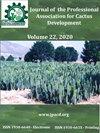Integrated management of agronomic practices in the forage cactus: maximising productivity, biological efficiency and economic profitability
IF 0.4
4区 农林科学
Q4 HORTICULTURE
Journal of the Professional Association for Cactus Development
Pub Date : 2022-12-10
DOI:10.56890/jpacd.v24i.514
引用次数: 2
Abstract
Forage cactus cropping systems that include a combination of agricultural practices (cloning, irrigation, mulching and/or intercropping) can increase forage production and economic return in semi-arid environments. This study evaluated the effect on productivity, biological efficiency and economic return of combining different practices with forage cactus cropping systems in the semi-arid region of Brazil. The research was conducted in four experimental areas, in a randomised block design with four replications, and included the following practices: 1) clones – irrigation - cover, 2) different irrigation depths, 3) intercropping - mulching, and 4) different levels of mulch. The treatments in experiment I consisted of three cactus clones (‘Orelha de Elefante Mexicana’—OEM; ‘Miúda’—MIU and ‘IPA-Sertânia’—IPA), two water regimes (rainfed and irrigated), and two levels of mulch (with and without mulch). Experiment II comprised four irrigation depths (0, 40, 80 and 120% of the crop evapotranspiration) and three cactus clones. In experiment III, three crop arrangements (single cactus, cactus intercropped with millet, and single millet) were evaluated under two levels of mulching (with and without mulching). In experiment IV, four levels of mulch were used (0, 5, 10 and 15 Mg ha-1). The total number of cladodes per plant, fresh matter yield (YFM), dry matter yield (YDM), and final plant density were obtained when harvesting. Economic viability was assessed using the profitability index (PI). The rainfed systems showed greater yield. The use of mulch afforded greater productivity. The OEM clone (YFM = 310.76 Mg ha-1 and YDM = 29.87 Mg ha-1) obtained a higher yield than did the IPA and MIU clones. The highest PI values were achieved under the rainfed systems. The MIU and IPA clones exhibited lower PI values. The cactus-millet intercrop achieved the best performance with the use of mulch. Cactus systems of 15.0 Mg ha-1 showed a greater PI value. It was concluded that the integrated management of such practices as intercropping, mulching and the adoption of the OEM clone can increase the supply of forage. These practices can promote the sustainable intensification of forage input in Livestock Production Systems in semi-arid environments.饲草仙人掌农艺实践的综合管理:最大限度地提高生产力、生物效率和经济效益
在半干旱环境中,包括农业实践(克隆、灌溉、覆盖和/或间作)组合的饲料仙人掌种植系统可以提高饲料产量和经济回报。本研究评估了在巴西半干旱地区将不同做法与饲草仙人掌种植系统相结合对生产力、生物效率和经济回报的影响。这项研究在四个实验区进行,采用随机区组设计,四次重复,包括以下实践:1)无性系-灌溉-覆盖,2)不同灌溉深度,3)间作-覆盖,4)不同覆盖水平。实验I中的处理包括三个仙人掌无性系(“Orelha de Elefante Mexicana”——OEM;“Miúda”——MIU和“IPA Sertânia”——IPA),两种水情(降雨和灌溉),以及两种覆盖水平(有覆盖物和无覆盖物)。实验II包括四个灌溉深度(作物蒸散量的0%、40%、80%和120%)和三个仙人掌无性系。在实验III中,在两个覆盖水平(有覆盖和无覆盖)下,对三种作物安排(单株仙人掌、仙人掌与小米间作和单株小米)进行了评估。在实验IV中,使用了四个水平的覆盖物(0、5、10和15 Mg ha-1)。收获时获得单株枝节总数、新鲜物质产量(YFM)、干物质产量(YDM)和最终植株密度。使用盈利能力指数(PI)评估经济可行性。雨水灌溉系统显示出更大的产量。覆盖物的使用提供了更高的生产力。OEM克隆(YFM=310.76 Mg ha-1和YDM=29.87 Mg ha-)获得了比IPA和MIU克隆更高的产量。在雨养系统下获得了最高的PI值。MIU和IPA克隆表现出较低的PI值。仙人掌-小米间作地膜覆盖效果最好。15.0 Mg ha-1的仙人掌系统显示出更大的PI值。结果表明,间作、覆盖和采用OEM克隆等措施的综合管理可以增加牧草的供应。这些做法可以促进半干旱环境中畜牧生产系统中饲料投入的可持续集约化。
本文章由计算机程序翻译,如有差异,请以英文原文为准。
求助全文
约1分钟内获得全文
求助全文
来源期刊

Journal of the Professional Association for Cactus Development
Agricultural and Biological Sciences-Plant Science
CiteScore
1.10
自引率
33.30%
发文量
10
期刊介绍:
The editors of the Journal of the Professional Association for Cactus Development, are very excited to be a part of the excellent editorial committee and to work together to create the synergism between scientists, growers, legislators, and business people so vital to the development of this industry to serve the people of arid lands.
 求助内容:
求助内容: 应助结果提醒方式:
应助结果提醒方式:


